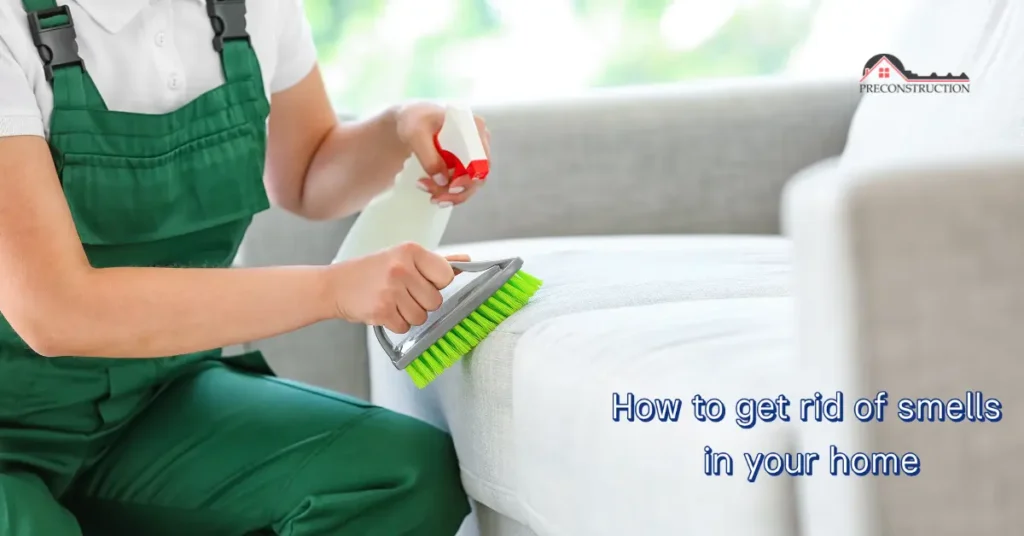Buying a new home is an exciting milestone. The thrill of stepping into a place that’s finally yours is unmatched—but what happens when that dream home comes with lingering odours that just won’t quit? From musty basements to pet accidents and cigarette residue, stubborn smells can turn your fresh start into a frustrating challenge. The good news? You don’t have to live with them.
In this comprehensive guide, we’ll take a deep dive into the most common causes of household odours and provide detailed, effective solutions to help you reclaim your space. Whether you’re dealing with mystery smells in a recently purchased home, prepping a property for sale, or simply want to refresh your living space, we’ve got you covered.
Why Odour Elimination Matters
Before we get into the nitty-gritty, let’s take a moment to understand why eliminating odours is so important.
First Impressions: Whether it’s for visitors, potential buyers, or even your own peace of mind, a home that smells fresh feels clean, welcoming, and cared for.
Health Implications: Many odours are linked to underlying issues like mould, poor ventilation, or pet waste, which can affect indoor air quality and potentially your health.
Emotional Comfort: Smells are tied to memory and emotion. A home that smells off can keep you from fully relaxing and feeling “at home.”
Let’s explore how to tackle odours by type.
1. Musty or Mouldy Smells
The Cause:
Musty smells usually stem from excess moisture, poor ventilation, or mould growth. Basements, crawl spaces, and bathrooms are frequent culprits due to their high humidity and low airflow.
How to Eliminate:
Step 1: Identify Moisture Sources
Inspect for:
Leaky pipes under sinks or behind toilets
Condensation on windows
Damp spots in basements or attics
Roof or foundation leaks
Use a moisture meter to measure dampness in walls and floors if you’re unsure.
Step 2: Clean and Dehumidify
Use Vinegar: A 1:1 solution of white vinegar and water sprayed on non-porous surfaces can kill some surface mould.
Mould Cleaners: Choose products specifically formulated for mould removal.
Dehumidifiers: Run them in problem areas to maintain humidity below 50%.
Ventilation: Install exhaust fans in bathrooms and kitchens, or simply open windows when weather allows.
Step 3: Professional Help
If you see more than 10 square feet of mould, call a professional. Mould remediation teams use HEPA vacuums, commercial-grade cleaners, and containment systems to prevent further spread.
2. Cigarette Smoke
The Cause:
Tobacco smoke contains thousands of chemicals that embed themselves in porous surfaces such as walls, carpets, drapes, and even HVAC systems. These particles linger long after smoking has stopped.
How to Eliminate:
Step 1: Surface Cleaning
Walls/Ceilings: Use a solution of vinegar and water or trisodium phosphate (TSP) cleaner. Wipe down all surfaces.
Cabinets/Doors: Don’t forget to clean woodwork and hardware.
Windows: Nicotine film can build up on glass, so use window cleaner or vinegar.
Step 2: Repainting
Use an odour-sealing primer before repainting walls or ceilings. Regular paint won’t block the smell; look for shellac- or oil-based primers.
Step 3: Soft Surfaces
Carpets: Steam clean or replace. Smoke particles embed deep into fibers.
Upholstery: Use fabric cleaners or consider reupholstering.
Curtains: Wash or dry-clean.
Step 4: Air Treatment
Replace HVAC filters.
Clean air ducts.
Use air purifiers with HEPA and carbon filters.
3. Pet Odours
The Cause:
Pet odours come from dander, fur, saliva, and the occasional accident. Over time, these smells can embed into fabric, carpets, and even flooring underlayment.
How to Eliminate:
Step 1: Deep Cleaning
Baking Soda: Sprinkle on carpets, let sit overnight, and vacuum.
Vinegar Spray: Effective for light deodorizing (avoid for urine spots).
Steam Cleaning: Safe for general grime but avoid it for urine due to heat setting the odour.
Step 2: Urine Stains
Use enzyme-based cleaners that break down urine proteins.
Soak the area thoroughly.
Let it sit for the recommended duration.
Blot dry, repeat if needed.
Avoid ammonia-based products. Pets may mistake the scent as a marker and re-soil the area.
Step 3: When to Replace
If odours persist, padding beneath carpets may be compromised. Replacement is often the only solution in this case.
Step 4: Preventative Measures
Bathe pets regularly.
Vacuum with a HEPA filter vacuum cleaner.
Use furniture covers that can be washed easily.
4. Sewer or Rotten Egg Smells
The Cause:
Often caused by dry plumbing traps, bacteria buildup, or blocked vents. In rare cases, it could also indicate a natural gas leak.
How to Eliminate:
Step 1: Run the Water
If a drain isn’t used frequently, the water in the P-trap (which blocks sewer gases) may evaporate. Run water in all sinks, tubs, and floor drains weekly.
Step 2: Drain Cleaning
Pour a half-cup of baking soda down the drain.
Follow with a cup of vinegar.
Wait 15 minutes, then rinse with boiling water.
Step 3: Venting Issues
Check for slow-draining sinks or bubbling toilets—signs that your vent pipes are blocked. Call a plumber for inspection.
Step 4: Check for Gas Leaks
Smells like sulphur or rotten eggs might signal a gas leak.
Leave immediately.
Don’t turn on lights or use electrical devices.
Call emergency services or your gas provider.
5. Kitchen and Cooking Odours
The Cause:
Grease, burnt food, and strong spices can linger for days, especially if ventilation is poor.
How to Eliminate:
Step 1: Clean Thoroughly
Wipe down kitchen walls, cabinets, and appliances with degreaser or vinegar solution.
Clean the oven, stovetop, and exhaust fan filters.
Step 2: Deodorize
Boil citrus peels, cinnamon sticks, or vinegar.
Place bowls of baking soda or activated charcoal around the kitchen.
Use a splatter screen when frying to reduce mess.
Step 3: Upgrade Ventilation
Consider installing or improving range hoods and ensuring kitchen fans vent to the outdoors.
6. Garbage and Organic Smells
The Cause:
Food waste, compost bins, and garbage disposals can all develop pungent odours quickly.
How to Eliminate:
Step 1: Garbage Disposal
Run cold water while grinding citrus peels and ice cubes.
Clean with a toothbrush and baking soda around the splash guard.
Step 2: Trash Cans
Wash with hot water and dish soap regularly.
Use liners with odour control.
Sprinkle baking soda in the bottom between uses.
Step 3: Compost
If composting indoors, use a tightly sealed bin with a carbon filter. Empty regularly and wash thoroughly.
7. New Home Smells (Paint, Varnish, Construction)
The Cause:
VOCs (volatile organic compounds) from paint, varnishes, new carpet, and synthetic materials.
How to Eliminate:
Step 1: Ventilation
Open windows and doors to allow air exchange.
Step 2: Air Purifiers
Use HEPA and activated carbon air purifiers to capture airborne particles and VOCs.
Step 3: Natural Absorbers
Place bowls of baking soda or activated charcoal around.
Add houseplants like peace lilies or spider plants (some are known for air purification).
Bonus Tips: Refresh Your Whole Home
Wash All Fabrics
Launder curtains, cushion covers, blankets, and linens.
Don’t forget to clean closet interiors and dresser drawers.
Air Out Furniture
Place furniture in sunlit, well-ventilated rooms. Sunlight can help kill bacteria and reduce smells.
Clean HVAC System
Replace all filters.
Consider professional duct cleaning if odours are traveling through the vents.
Try Natural Scents
Once odours are eliminated, introduce pleasant scents:
Essential oil diffusers
Simmer pots
Scented candles (used sparingly for those with sensitivities)
When to Call the Pros
Some smells are more than surface-level. Call in professionals when:
Mould affects multiple rooms.
Urine odours persist after deep cleaning.
Smoke damage remains despite repainting.
Plumbing issues create continuous foul smells.
Specialists have access to industrial-strength equipment and methods that go beyond DIY capabilities, such as ozone treatments or thermal fogging.
Conclusion: Make It Feel Like Home
Getting rid of stubborn odours isn’t just about cleanliness—it’s about peace of mind. When your space smells fresh, you breathe easier, sleep better, and feel more at home. With a mix of elbow grease, smart cleaning strategies, and—when needed—professional help, even the most pungent smells can become a thing of the past.
Every home has a history, but with the right approach, you can ensure that your space only reflects your story. A fresh-smelling home is a happy home—and one worth investing in.






